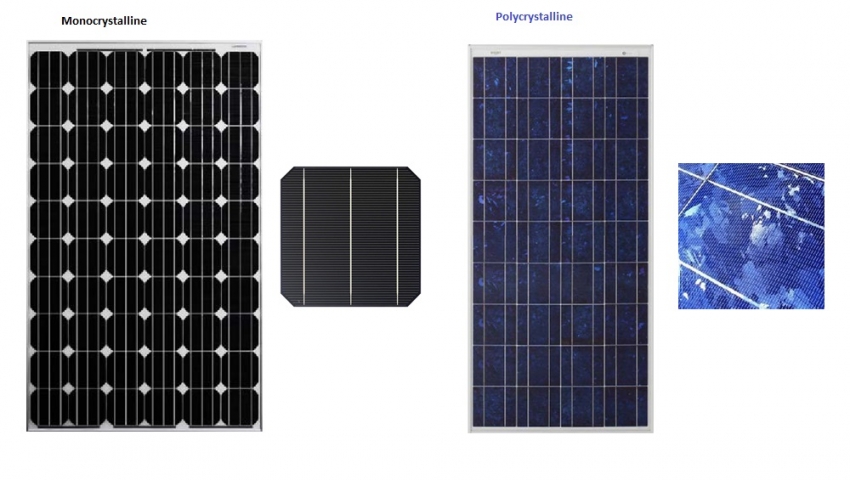Monocrystalline vs Polycrystalline Solar Panels
Discover how much you can save today with our solar calculator
Choose Wisely: Are Monocrystalline or Polycrystalline Solar Panels Right for You?
There are many decisions to be made when you’re considering a solar panel system for your home, but few cause as much confusion and consternation as choosing which panel type to install. There are several options from which to choose, but the most common are monocrystalline and polycrystalline panels. These materials are rather similar, but each offers its own set of advantages and disadvantages. To help you understand which type is best for you, let’s jump in and take a closer look.
What Is the Difference Between Monocrystalline and Polycrystalline Solar Panels?
Monocrystalline Solar Panels
First and foremost, both monocrystalline and polycrystalline solar panels serve a similar function. Both are made from thin layers of silicon, which utilize photons from sunlight to generate electricity. Monocrystalline panels are created through a method called the Czochralski process, in which a single seed crystal is dipped into a crucible of molten high-purity silicon. The seed crystal is then slowly pulled upward while being rotated, producing a pure, solid block of silicon that is composed of a single crystal – hence the “monocrystalline” name. This block is then cut into a square shape and sliced into thin, uniform wafers that are used to build solar panels.
This process is relatively labor-intensive and produces waste when the silicon blocks are cut into squares, which means monocrystalline panels are more costly to produce. However, because each panel is composed of a single large, uniform crystal, they are about 10 to 15 percent more efficient than polycrystalline on average. They also perform slightly better in shady or high-temperature conditions. Some people also prefer the dark, uniform color that is characteristic of monocrystalline solar panels.

Polycrystalline Solar Panels
By contrast, the process for creating polycrystalline panels – also sometimes called multi-crystalline panels – is much quicker and simpler. A crystal seed is placed into a square mold along with molten silicon, where it’s allowed to set and cool undisturbed. Because the outer edges of the silicon cool more rapidly than the center portion, this process results in the creation of many smaller crystals that are distributed throughout the material. The cast silicon is then cut into wafers similar to the monocrystalline material.
The simpler process means manufacturing polycrystalline panels is less costly – about 20 percent less on average – and produces less silicon waste. However, the less orderly internal structure of polycrystalline panels means that electrons don’t flow through it quite as easily. As a result, these panels are typically somewhat less efficient, though this gap has steadily narrowed in recent years. The fragmented, blue-tinted appearance of the panels is also less appealing to some people, though this is a purely cosmetic choice.
Which Solar Panel Is Best: Polycrystalline or Monocrystalline?
Considering monocrystalline solar panels are more efficient and more effective in hot or low-light conditions, you may assume that these panels are almost always the best choice. In reality, there are trade-offs to both options and one is not inherently better than the other. In order to determine the best choice for your specific needs, there are two primary factors to consider.
Space Constraints
Because of their increased efficiency, the primary advantage of monocrystalline solar panels is that they can generate more power per square foot than comparable polycrystalline panels. This is particularly important if you have limited space in which to install a solar energy system. If you’re operating within strict space constraints, the higher cost of monocrystalline panels may be worth it to ensure that you’re maximizing every inch and generating as much power as possible.
Overall System Cost
Among the many considerations when it comes to deciding on a solar panel system, one of the most important is the overall expense of the system. Polycrystalline panels generally offer greater up-front savings as long as you have enough space, but it’s important to do your research to make sure you’re getting the best deal. Add up the cost per watt of each panel you’re considering to establish a baseline, but don’t forget to factor in the cost of installation.
Ultimately, there are no one-size-fits-all solutions for solar panel systems. It’s best to determine how many solar panels to power a home and use that information to assess whether you need the greater efficiency of monocrystalline solar panels. Whichever material type you choose, it’s important to pick a high-quality solar panel that offers efficiency and durability. SunPower, Panasonic, and LG are generally regarded as the premier solar panel manufacturers on the market today, and each offers a range of panels with an ironclad 25-year warranty.
Solar energy is a great investment that can help you save money and do your part to save the environment, but navigating the dizzying array of options and terms can feel overwhelming. It’s imperative to understand your specific needs and goals in order to get the best bang for your solar buck. Armed with the information above, you can make a more confident and informed decision regarding which solar panel material is best for you.
Ready to See How Much You Can Save with Solar?
Interested in getting exact prices for the cost solar for your home? Get competitive solar quotes from qualified, trusted installers in your area. To see an estimate for how much you could expect to save and how much a solar system would cost, try our solar calculators.

